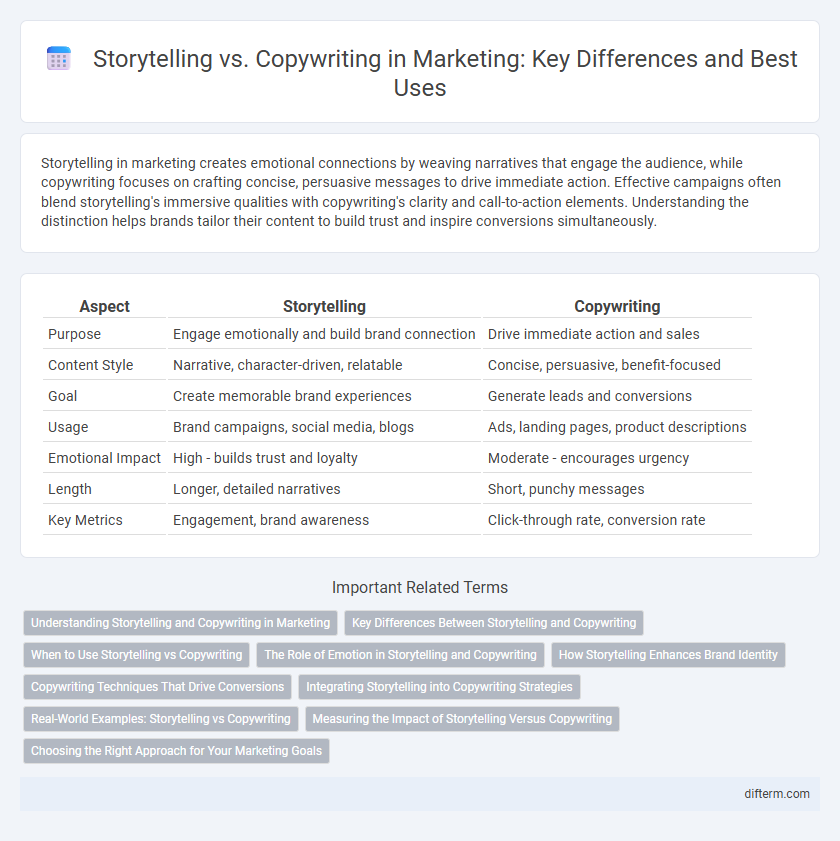Storytelling in marketing creates emotional connections by weaving narratives that engage the audience, while copywriting focuses on crafting concise, persuasive messages to drive immediate action. Effective campaigns often blend storytelling's immersive qualities with copywriting's clarity and call-to-action elements. Understanding the distinction helps brands tailor their content to build trust and inspire conversions simultaneously.
Table of Comparison
| Aspect | Storytelling | Copywriting |
|---|---|---|
| Purpose | Engage emotionally and build brand connection | Drive immediate action and sales |
| Content Style | Narrative, character-driven, relatable | Concise, persuasive, benefit-focused |
| Goal | Create memorable brand experiences | Generate leads and conversions |
| Usage | Brand campaigns, social media, blogs | Ads, landing pages, product descriptions |
| Emotional Impact | High - builds trust and loyalty | Moderate - encourages urgency |
| Length | Longer, detailed narratives | Short, punchy messages |
| Key Metrics | Engagement, brand awareness | Click-through rate, conversion rate |
Understanding Storytelling and Copywriting in Marketing
Storytelling in marketing leverages emotional engagement and narrative structures to build brand identity and connect with audiences on a deeper level, enhancing memorability and trust. Copywriting focuses on persuasive language that drives specific actions, such as clicks, sign-ups, or purchases, emphasizing clarity and immediacy. Understanding the distinct roles of storytelling and copywriting enables marketers to craft campaigns that balance emotional resonance with direct calls to action, optimizing overall effectiveness.
Key Differences Between Storytelling and Copywriting
Storytelling engages audiences by weaving narratives that evoke emotions and build brand identity, creating a memorable experience that fosters loyalty. Copywriting focuses on concise, persuasive language designed to drive immediate actions such as sales, clicks, or sign-ups. The key difference lies in storytelling's emphasis on immersive connection versus copywriting's goal of clear, compelling calls to action.
When to Use Storytelling vs Copywriting
Storytelling is most effective when building brand identity, fostering emotional connections, and engaging audiences through memorable narratives. Copywriting excels in driving immediate action, such as conversions, sales, or sign-ups, by delivering clear, concise, and persuasive messages. Choosing between storytelling and copywriting depends on campaign goals, with storytelling suited for long-term brand loyalty and copywriting optimized for short-term performance metrics.
The Role of Emotion in Storytelling and Copywriting
Emotions play a crucial role in storytelling by creating deep connections that engage audiences and foster brand loyalty. In copywriting, emotional triggers are strategically used to persuade and drive immediate action, such as clicks or purchases. Effective marketing leverages both emotional storytelling to build trust and resonant copywriting to convert interest into measurable results.
How Storytelling Enhances Brand Identity
Storytelling enhances brand identity by creating emotional connections that differentiate a brand from competitors and foster customer loyalty. Integrating authentic narratives into marketing strategies humanizes the brand, making it more relatable and memorable to the target audience. Effective storytelling drives engagement and reinforces brand values, leading to increased customer trust and long-term growth.
Copywriting Techniques That Drive Conversions
Effective copywriting techniques that drive conversions include using clear, persuasive language that highlights the product's unique benefits and addresses customer pain points directly. Incorporating strong calls-to-action (CTAs) and social proof, such as testimonials or reviews, significantly boosts credibility and encourages immediate response. Crafting concise, emotionally resonant headlines paired with targeted keywords optimizes engagement and enhances search engine visibility.
Integrating Storytelling into Copywriting Strategies
Integrating storytelling into copywriting strategies enhances brand engagement by creating relatable narratives that resonate with target audiences. Crafting emotional journeys within persuasive copy increases conversion rates and fosters customer loyalty through authentic connections. Utilizing storytelling elements such as character development, conflict, and resolution amplifies message retention and drives more effective marketing campaigns.
Real-World Examples: Storytelling vs Copywriting
Brand Nike's "Just Do It" campaign demonstrates the power of copywriting through concise, motivational messaging that drives immediate action. In contrast, Airbnb's "Belong Anywhere" storytelling approach builds emotional connections by sharing authentic traveler experiences that foster brand loyalty. Both methods leverage different tactics: copywriting for direct persuasion and storytelling for deep engagement, effectively enhancing marketing outcomes.
Measuring the Impact of Storytelling Versus Copywriting
Measuring the impact of storytelling versus copywriting involves analyzing engagement metrics such as click-through rates, conversion rates, and audience retention. Storytelling often drives deeper emotional connection, resulting in higher brand loyalty and longer-term customer value, whereas copywriting typically excels in prompting immediate actions and sales. Assessing performance through A/B testing and customer feedback can reveal which approach yields better ROI depending on campaign goals.
Choosing the Right Approach for Your Marketing Goals
Storytelling engages audiences by creating emotional connections and brand loyalty, making it ideal for long-term marketing goals. Copywriting drives immediate action through compelling calls-to-action and persuasive language, suited for short-term campaigns and conversions. Evaluating your target audience and campaign objectives ensures the selection of the most effective approach for maximizing ROI.
storytelling vs copywriting Infographic

 difterm.com
difterm.com